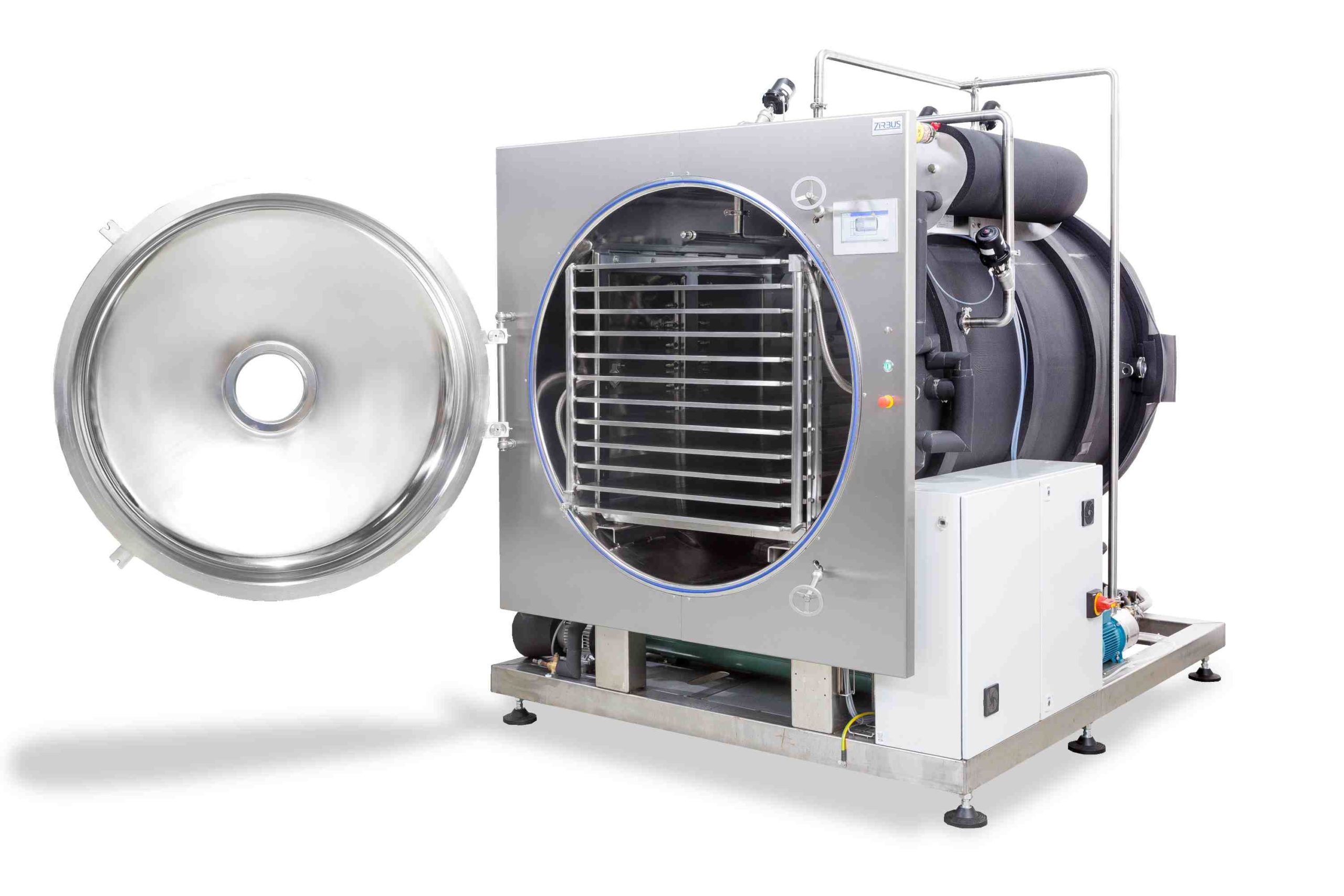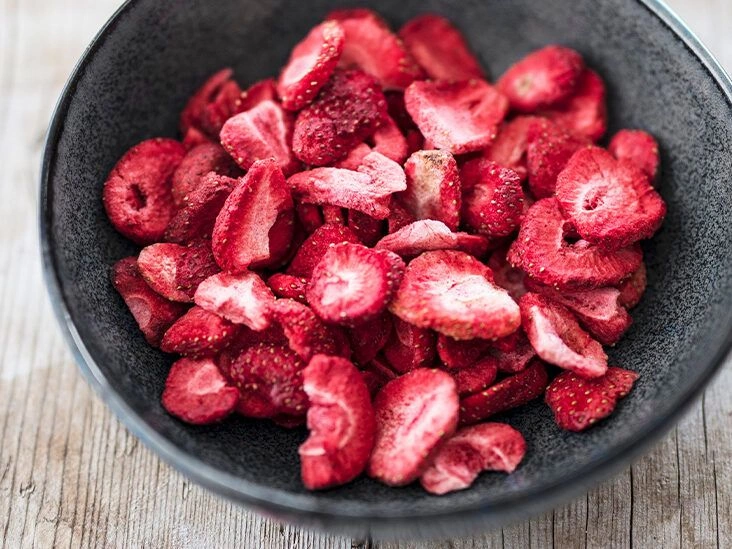Freeze-drying, or lyophilization, is a dehydration technique. Food is initially frozen and then dried under reduced pressure to eliminate its moisture.
Many consider freeze-drying the superior drying method. For that reason, it’s widely used in the food and pharmaceutical sectors.
From instant meals to fruit snacks, you’ll commonly find numerous freeze-dried products on supermarket shelves.
This article describes freeze-drying in more detail and examines whether it’s a healthy option.

What is freeze-drying?
Freeze-drying, also called lyophilization, is a dehydration approach that relies on sublimation — the direct transition of water from solid to gas.
In other words, the water in the product goes from ice to vapor without melting into liquid.
Freeze-drying is regarded as a premium dehydration method for several reasons, such as (, ):
- it operates at low temperatures, which helps preserve nutrients, flavor, appearance, and heat-sensitive constituents
- freezing slows chemical and microbial activity, considerably delaying spoilage and extending shelf life
How does it work?
Fresh fruits, vegetables, and meats contain a lot of water, which exists as “free” and “bound” water. Free water freezes easily, while bound water does not.
During freeze-drying, all free water and some bound water must be removed, and the free water must remain frozen throughout. This is the main difference from vacuum-drying and the most demanding part of the process.
The freeze-drying procedure usually includes three stages (, , ):
- Freezing: The product is typically frozen at atmospheric pressure.
- Primary drying: Also called the main freeze-drying phase, this is the sublimation stage where frozen free water is extracted.
- Secondary drying: Also called desorption drying, this reduces the remaining bound water to reach the target moisture level.
Freeze-drying must be done under controlled conditions to prevent melting, since liquid water can change a product’s composition, form, and physical qualities.
If melting occurs, the product’s shelf life may be significantly shortened.
After the frozen water is removed by sublimation, the leftover material becomes highly porous. Reintroducing water will rehydrate the product very quickly.
SummaryFreeze-drying is a dehydration method that removes moisture by converting ice into vapor. Its three-stage process helps maintain nutrients, flavor, and appearance while prolonging shelf life.
Are freeze-dried foods healthy?
Freeze-dried products are a nutritious choice. Freeze-drying is among the preferred dehydration techniques because of its many advantages.
This method excels at preserving the activity of beneficial plant compounds like phytochemicals and nutrients while maintaining color, aroma, and texture. That’s why it’s frequently used for premium food products.
For example, research indicates that compared with other drying approaches, freeze-drying best preserves antioxidants such as anthocyanins, flavonoids, and ascorbic acid (vitamin C).
Antioxidants are valuable molecules that help counteract oxidative stress in the body. They largely account for the health advantages of many fruits and vegetables.
That said, while freeze-drying can sometimes increase a fruit’s concentration of phytochemicals, results vary by fruit and the opposite effect can occur.
Moreover, because lower water activity suppresses the growth of most bacteria, yeasts, and molds, removing moisture via freeze-drying helps extend a food’s shelf life.
This is particularly useful for fresh plant foods that aren’t available year-round.
Finally, eliminating water reduces product volume and weight, making storage, handling, and transportation easier.
SummaryFreeze-drying helps preserve nutrients and phytochemicals, making freeze-dried foods a healthy option. It also extends shelf life and simplifies storage and transport.
Foods that can be freeze-dried
Freeze-dried foods are popular for hiking, camping, space missions, emergency supplies, and military rations due to their low weight, long shelf life, portability, and quick preparation.
Although plant-based items are the most commonly freeze-dried, a broad variety of foods can be preserved this way.
Below are some foods that can be freeze-dried (, , ):
- Fruits: strawberries, apples, blackberries, bananas, pears, oranges, and fruit purée
- Vegetables: nearly all vegetables, including carrots, asparagus, mushrooms, peppers, pumpkin, and tomatoes
- Meats: beef, fish, chicken, eggs, pork, turkey, and shrimp
- Grains: cooked rice, beans, pasta, quinoa, and polenta
- Legumes: cooked beans, lentils, peas, and tofu
- Prepared meals: complete dishes like Pad Thai, stews, chili, and snack items
- Beverages: milk, juices, coffee, and tea for instant drinks
- Herbs and spices: ginger, oregano, mint, basil, and garlic
- Sweeteners: maple syrup for powdered sugar substitutes
SummaryA diverse array of foods can be preserved by freeze-drying, including fruits, vegetables, meats, complete meals, grains, drinks, spices, and sweeteners.
Potential downsides of freeze-drying
Freeze-drying is an outstanding preservation technique, but it has some drawbacks to keep in mind.
First, although lowering water activity hinders microbial growth, pathogens in raw meat or eggs may survive the drying and remain during storage. They can cause foodborne disease if consumed without proper cooking.
Foods may be freeze-dried either cooked or raw. If you freeze-dry raw meat or eggs, proper labeling and cooking before consumption are required (10).
Second, despite maintaining antioxidant levels, the porous nature of freeze-dried products permits easy oxygen access, which can accelerate oxidation or breakdown of bioactive compounds.
SummaryFreeze-drying does not eliminate all bacteria in raw foods. Cook raw items before freeze-drying to avoid foodborne illness. Also, high porosity may increase nutrient degradation due to oxidation.
Can you freeze-dry foods at home?
Freeze-drying requires specialized, often costly machinery that operates under precise temperature and pressure conditions.
It’s not advisable to attempt freeze-drying without the appropriate equipment and training.

SummaryFreeze-drying demands specialized equipment and is unsafe to attempt without it.
The bottom line
Freeze-drying is a dehydration technique that converts ice into vapor through sublimation.
It’s a healthy preservation method because it retains most beneficial plant compounds and nutrients, along with color, flavor, and texture.
However, it doesn’t destroy harmful microorganisms, so thoroughly cook freeze-dried raw items like meat or eggs before eating.
Freeze-drying requires specific equipment. If you don’t own a home freeze-drying unit, don’t try to freeze-dry foods.


















Leave a Reply
You must be logged in to post a comment.